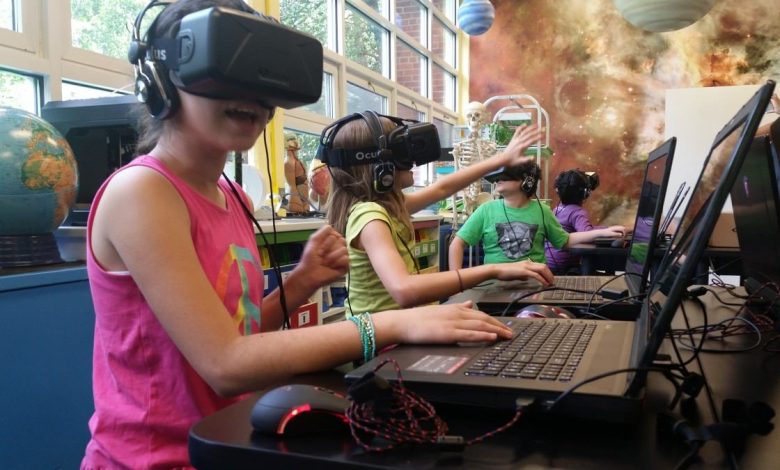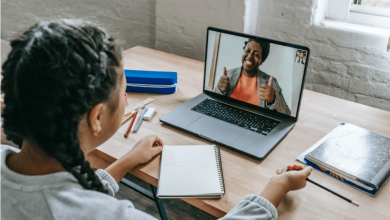Virtual Reality In Education Benefits, Tools & Case Studies

Virtual Reality in Education: Benefits, Tools & Case Studies introduces a transformative approach to modern learning, where immersive experiences replace traditional methods to captivate students. As educational institutions increasingly embrace technology, virtual reality emerges as a powerful tool that not only enhances engagement but also accommodates various learning styles. This innovation holds the potential to revolutionize classrooms by providing unique opportunities for exploration and interaction beyond the confines of conventional curricula.
In this discussion, we will explore the evolution of virtual reality in education, its numerous benefits, the tools available for educators, and insightful case studies highlighting successful implementations. By understanding both the opportunities and challenges presented by this technology, we can better appreciate its role in shaping the future of learning.
Overview of Virtual Reality in Education

Virtual reality (VR) has emerged as a transformative force in the educational sector, offering immersive experiences that go beyond traditional learning methods. By simulating real-world environments and scenarios, VR enables students to engage with content in a dynamic way, fostering deeper understanding and retention of knowledge. Its significance in education is underscored by the ability to create safe, controlled environments where learners can practice skills and experiment with concepts without the risks associated with real-life applications.
The evolution of virtual reality technology over the past few decades has paved the way for its integration into classrooms. Initially, VR was largely confined to specialized labs and expensive equipment. However, advancements in technology have led to the development of more affordable and accessible VR solutions. Schools and educational institutions are now adopting VR tools that range from headsets to software applications designed specifically for educational use, allowing educators to create engaging learning experiences across various subjects, from science to history.
Potential to Enhance Learning Experiences
The incorporation of virtual reality in education has the potential to significantly enhance learning experiences by providing students with interactive and engaging ways to absorb information. Various aspects of VR contribute to this potential, which includes:
– Immersive Learning Environments: VR can transport students to different times and places, allowing them to experience historical events or explore the depths of the ocean, thus making learning more engaging and contextual.
– Skill Development: In fields such as medicine or engineering, VR can simulate complex procedures, enabling students to practice and refine their skills in a safe, risk-free environment. This hands-on experience is invaluable for building confidence and competence.
– Collaboration and Social Interaction: Virtual reality can facilitate collaborative learning experiences where students from different geographical locations can interact and work together in a shared virtual space, enhancing teamwork and communication skills.
– Personalized Learning Paths: VR technology allows for tailored educational experiences based on individual learning styles and paces. Students can navigate through lessons that suit their specific needs, fostering a more inclusive learning environment.
– Engagement and Motivation: The novelty and excitement of VR can boost student motivation and engagement. By providing interactive simulations and games, learning becomes more enjoyable and less intimidating.
The implementation of VR in education has already shown promising outcomes in various case studies, demonstrating improved retention rates, enhanced understanding of complex subjects, and increased student engagement. As technology continues to advance, the possibilities for virtual reality in education are boundless, promising exciting developments for future generations of learners.
Benefits of Virtual Reality in Education: Virtual Reality In Education: Benefits, Tools & Case Studies
The integration of virtual reality (VR) into educational environments offers a plethora of advantages that enhance both teaching methodologies and learning experiences. By providing immersive and interactive simulations, VR not only enriches the curriculum but also equips students with essential skills for the future.
One of the key advantages of using VR in education is its ability to significantly increase student engagement and motivation. Traditional teaching methods often struggle to hold the attention of students, especially in a world filled with digital distractions. However, VR captivates learners by creating realistic scenarios that they can explore and interact with, making the educational process more enjoyable and impactful. This interactive nature fosters a deeper connection with the material, as students are not mere observers but active participants in their learning journey.
Increased Engagement and Motivation
The immersive experiences offered by VR have been shown to motivate students and increase participation. By engaging multiple senses, VR creates memorable learning experiences that enhance retention. The following points illustrate how VR can boost engagement:
- Immersive Learning Environments: VR transports students to different settings, such as historical sites or scientific laboratories, allowing them to experience lessons firsthand.
- Interactive Simulations: Programs that simulate real-world applications of concepts encourage students to apply their knowledge in practical scenarios, enhancing their understanding.
- Gamification: Many VR educational applications include game-like elements, which can motivate students to achieve learning objectives while enjoying the process.
Impact on Different Learning Styles and Needs
Virtual reality has the capacity to address various learning styles, making education more inclusive. The adaptability of VR can cater to visual, auditory, and kinesthetic learners, ensuring that all students have the opportunity to thrive. This versatility is particularly beneficial for students with special educational needs, as VR can be customized to suit individual requirements. Key benefits include:
- Visual Learning: VR enhances visual learning by providing graphic representations of concepts, aiding those who learn best through visual stimuli.
- Auditory Support: Many VR programs include audio instructions and narratives, catering to auditory learners who benefit from listening.
- Hands-on Experiences: VR offers kinesthetic learners practical experiences in a safe environment, allowing them to practice skills without real-world consequences.
The application of virtual reality in education not only transforms the teaching and learning landscape but also prepares students for the complexities of the modern world. By focusing on engagement and inclusivity, VR serves as a powerful tool that can enhance educational outcomes across diverse populations.
Tools and Technologies for Virtual Reality in Education

The integration of virtual reality (VR) into education has seen a significant rise in popularity due to its ability to create immersive learning experiences. Various platforms and tools have emerged to cater to the educational sector, facilitating enhanced engagement and understanding of complex subjects. By utilizing these technologies, educators can foster interactive learning environments that stimulate student interest and comprehension.
Several popular virtual reality platforms have been developed specifically for educational purposes. These tools vary in their functionalities, ease of use, and pricing, allowing educators to choose the best fit for their needs. Below is an overview of some leading tools in the VR education space.
Popular Virtual Reality Platforms in Education
Educators have a variety of VR tools at their disposal. The following list highlights the most recognized platforms and their features:
- Oculus Quest 2: A standalone VR headset that provides access to a wide range of educational applications without needing a PC. It offers excellent graphics and a user-friendly interface.
- Google Expeditions: An application that allows users to explore virtual field trips and 3D models of historical landmarks, the human body, and more. It is compatible with smartphones and tablets.
- zSpace: A mixed-reality platform that combines VR and augmented reality (AR) for interactive learning experiences, particularly in STEM education. It requires specialized hardware.
- Engage: A virtual reality platform designed for education and training, offering tools for creating interactive VR lessons, events, and collaborative learning experiences.
Comparison Table of Various VR Tools
The following table provides a comparative overview of the features and pricing of various VR educational tools, assisting educators in making informed decisions.
| Tool | Features | Pricing |
|---|---|---|
| Oculus Quest 2 | Standalone, vast library of educational apps, high-quality graphics | $299 |
| Google Expeditions | Virtual field trips, 3D models, accessible on mobile devices | Free |
| zSpace | Mixed reality for STEM, interactive experiences, requires special hardware | Varies by school implementation |
| Engage | Collaborative learning, customizable VR lessons, event hosting | $10/month per user |
Integration of VR Tools into Curriculum
Educators can effectively incorporate VR tools into their existing curriculum by following strategic steps. Consideration of content objectives and student engagement is crucial in this process. The following points Artikel how to seamlessly integrate VR into lesson plans:
- Identify learning objectives that could benefit from immersive experiences, such as complex scientific concepts or historical events.
- Choose a VR tool that aligns with your curriculum needs, ensuring that it complements the subject matter being taught.
- Design assignments that incorporate VR experiences, such as virtual field trips or simulations, allowing students to engage with the content actively.
- Provide training and resources for both educators and students on how to use the VR tools effectively.
- Encourage collaborative projects that utilize VR, fostering teamwork and interactive learning among students.
With the right tools and strategies, virtual reality can enhance educational experiences, making learning more dynamic and impactful.
Case Studies of Successful Implementation
The integration of virtual reality (VR) into educational frameworks has been remarkably impactful, with various institutions showcasing its effectiveness through innovative projects. By examining specific case studies, we can glean insights into how VR technologies enhance learning experiences and outcomes for both students and educators.
Case Study: Stanford University’s Virtual Reality Experience, Virtual Reality in Education: Benefits, Tools & Case Studies
Stanford University has pioneered the use of virtual reality in the realm of education through its immersive learning project, which allows students to engage with complex concepts in an interactive environment. In this project, students participate in virtual simulations related to neuroscience, enabling them to visualize brain functions and diseases.
Feedback from students indicates a significant enhancement in their understanding of the subject matter. One student remarked,
“Experiencing the brain in 3D made the concepts much clearer and easier to remember.”
Educators have noted that students who engage with VR materials demonstrate improved retention rates and a greater capacity for critical thinking.
Case Study: University of Maryland’s Engineering Program
The University of Maryland implemented a comprehensive VR initiative within its engineering program, focusing on virtual prototyping and design. Through VR simulations, students can create and manipulate 3D models, testing their designs in real-time scenarios. The outcomes have been impressive, with a reported increase in student engagement and creativity in problem-solving.
Students have provided positive feedback, emphasizing that
“the ability to test our designs in a virtual space boosts our confidence and helps us learn faster.”
Faculty members have also recognized that VR fosters collaboration among students, as they can work together in a shared virtual environment, mirroring real-world engineering challenges.
Case Study: Immersive Learning at the University of Bristol
At the University of Bristol, the integration of VR into history classes allows students to experience historical events firsthand. One project involved reconstructing significant battles, enabling students to understand the strategic decisions made during these pivotal moments in history.
The results have been compelling; students reported heightened engagement and a deeper emotional connection to the material. One student shared,
“Being in the middle of a historical event made it feel real and much more impactful than reading about it in a book.”
Educators noted that this immersive experience encourages students to participate more actively in discussions and seek additional resources for further learning.
Case Study: Virtual Reality in K-12 Education at the New York City Department of Education
The New York City Department of Education has successfully integrated VR into various K-12 classrooms. One notable project involves using VR to enhance science curricula, allowing students to explore ecosystems and engage in virtual field trips to locations like the Amazon rainforest or the Great Barrier Reef.
Teachers reported substantial improvements in student engagement and knowledge retention. A teacher commented,
“When students can virtually visit a rainforest, their understanding of biodiversity and conservation becomes much more tangible.”
This approach not only captivates students’ imaginations but also broadens their perspectives on global issues.
Case Study: The Use of VR in Special Education at Tactile Vision
Tactile Vision is an institution that focuses on the education of visually impaired students. They have incorporated VR to create tactile and auditory experiences that allow these students to explore environments that would otherwise be inaccessible.
The outcomes have been profound, with students able to navigate through simulated spaces that replicate real-world settings. Feedback from educators highlights the empowerment felt by students, as one teacher stated,
“VR opens up a world of possibilities for our students, allowing them to experience things they never thought possible.”
This innovative use of technology has not only improved learning outcomes but has also fostered a sense of independence among students.
Challenges and Limitations
The integration of virtual reality (VR) in education presents numerous opportunities; however, it is not without its challenges and limitations. Educators and institutions often encounter various barriers that can impede the successful implementation of VR technologies in the classroom. Understanding these challenges is crucial for developing effective strategies to enhance the educational experience through VR.
One significant challenge educators face when adopting virtual reality is the high cost of VR equipment and software. Budget constraints can limit access to the latest technologies, particularly for schools in economically disadvantaged areas. Moreover, the requirement for ongoing maintenance and updates can further strain limited educational budgets.
Another challenge is the lack of training and technical support for educators. Many teachers may feel unprepared to incorporate VR into their teaching practices due to a lack of familiarity with the technology. This can lead to resistance in adopting VR tools or ineffective usage of the available resources.
Cost and Budget Constraints
Understanding the financial implications of implementing VR in education is essential. The expenses associated with VR can be categorized into several key areas:
- Hardware Costs: VR headsets, computers, and related hardware can be expensive, often requiring significant initial investment.
- Software Licensing: Many VR educational applications come with licensing fees that can add to the overall costs.
- Maintenance and Upgrades: Keeping hardware and software up to date requires ongoing financial resources that educational institutions may not always have.
To address these financial challenges, institutions can explore partnerships with technology companies, seek grants specifically for technology integration, or implement phased rollouts that allow for gradual investment in VR resources.
Lack of Training and Support
The effective use of VR technology in education hinges on the ability of educators to utilize it effectively. Unfortunately, professional development opportunities specific to VR are often limited.
To mitigate this issue, educational institutions can implement several strategies:
- Professional Development Programs: Institutions should offer workshops and training sessions focused on using VR tools and integrating them into curricula.
- Peer Collaboration: Establishing a mentorship system where experienced educators can guide their peers in VR usage may enhance overall comfort levels with the technology.
- Resource Networks: Creating networks for educators to share resources, best practices, and experiences with VR can foster a supportive learning environment.
Technical Limitations of Virtual Reality
Beyond cost and training, technical limitations of VR technology can hinder its effectiveness in educational settings. Common technical issues include:
- Hardware Limitations: Certain VR systems require high-performance computers that may not be available in all schools.
- Content Availability: There is a limited amount of educational content specifically designed for VR, which can restrict how effectively the technology can be used across various subjects.
- User Experience: Some users may experience discomfort, such as motion sickness or fatigue, when using VR, which can detract from the learning experience.
To overcome these technical limitations, it is essential to continuously research and invest in user-friendly VR solutions, develop a broader range of educational content, and provide alternative instructional methods for students who may struggle with VR.
Future Trends in Virtual Reality and Education
The landscape of education is continuously evolving, and virtual reality (VR) stands at the forefront of this transformation. As technological advancements unfold, VR is expected to play a pivotal role in redefining learning experiences, making education more immersive and interactive. By analyzing emerging trends and innovations, we can gain insight into how VR will reshape the educational environment over the next decade.
Innovations in virtual reality promise to enhance the learning experience significantly. One trend is the increasing integration of artificial intelligence (AI) with VR, allowing for personalized learning paths that adapt to the individual needs of students. This integration enables educators to create tailored experiences that cater to diverse learning styles and paces, fostering a more inclusive educational environment.
Integration of Artificial Intelligence with Virtual Reality
The convergence of AI and VR is set to revolutionize the educational landscape. By leveraging AI algorithms, educators can analyze student performance and engagement metrics, enabling them to refine VR content dynamically. This integration can result in the following advancements:
- Personalized Learning Experiences: AI can create customized simulations that adapt in real-time to a student’s level of understanding, offering additional support or advanced challenges as needed.
- Intelligent Tutoring Systems: AI-driven avatars can act as tutors within VR environments, providing instant feedback and guidance to learners, thereby enhancing comprehension and retention.
- Data-Driven Insights: Educators can utilize data analytics derived from AI to identify trends in student performance, allowing for informed decisions regarding curriculum design and instructional strategies.
Another promising trend is the development of social VR platforms designed for collaborative learning. These platforms allow students from various locations to engage in shared virtual experiences, breaking down geographical barriers.
Collaborative Learning in Social Virtual Reality
Social VR is poised to reshape group learning dynamics, enabling students to work together in immersive environments. This approach fosters teamwork and communication skills, essential for future job markets. The key attributes of social VR include:
- Real-Time Collaboration: Students can interact and collaborate on projects within a shared virtual space, simulating real-world teamwork scenarios.
- Global Classroom Opportunities: Learners can connect with peers from around the world, gaining exposure to diverse perspectives and cultures, which enriches the learning experience.
- Enhanced Engagement: The immersive nature of social VR can significantly increase student motivation and participation, leading to deeper learning outcomes.
Moreover, advancements in hardware technology are expected to enhance VR accessibility in education. As devices become more affordable and user-friendly, educational institutions will increasingly adopt VR solutions.
Advancements in Hardware Technology for Education
The accessibility of VR technology is a critical factor in its future adoption within educational settings. Innovations in hardware are making VR more viable for a wider range of institutions. Key developments include:
- Affordable VR Headsets: The emergence of low-cost VR headsets allows schools with limited budgets to incorporate immersive technology into their curricula.
- Mobile VR Solutions: Smartphones are being utilized to deliver VR experiences, ensuring that a broader audience can access VR learning opportunities without the need for expensive equipment.
- Improved User Interfaces: Enhanced user interfaces are making VR applications more intuitive, reducing the learning curve for both educators and students.
As we look towards the future, it is predicted that virtual reality will become an integral part of everyday education, fostering an environment where learners can explore, create, and collaborate like never before. By 2030, educational institutions may ideally use VR in a variety of subjects, from science to arts, providing students with hands-on experiences that traditional classrooms cannot offer.
“The future of education is immersive, interactive, and interconnected, with VR leading the charge towards a more engaging and effective learning experience.”
Final Review
In conclusion, the integration of Virtual Reality in Education: Benefits, Tools & Case Studies illustrates the remarkable potential of this technology to engage learners and enhance their educational experiences. From increased motivation to tailored learning approaches, VR stands at the forefront of educational innovation. As we move forward, addressing challenges and embracing emerging trends will be crucial in harnessing the full capabilities of virtual reality within educational settings, paving the way for a more interactive and enriching learning environment.
FAQ Section
What is virtual reality in education?
Virtual reality in education refers to the use of immersive technology to create simulated environments that enhance learning experiences.
How does virtual reality increase student engagement?
It captivates students by offering interactive and lifelike experiences that stimulate interest and participation in learning activities.
What are some common tools used for virtual reality in education?
Popular tools include Oculus Rift, Google Expeditions, and HTC Vive, each offering unique features tailored for educational purposes.
What challenges do educators face when implementing VR?
Common challenges include high costs, insufficient training, and the need for adequate infrastructure to support VR technology.
How can VR cater to different learning styles?
VR provides diverse modalities, allowing visual, auditory, and kinesthetic learners to engage with content in ways that suit their individual preferences.
What are the future trends for VR in education?
Emerging trends include advancements in AI integration, enhanced interactivity, and wider accessibility, which are expected to further enrich educational experiences.







